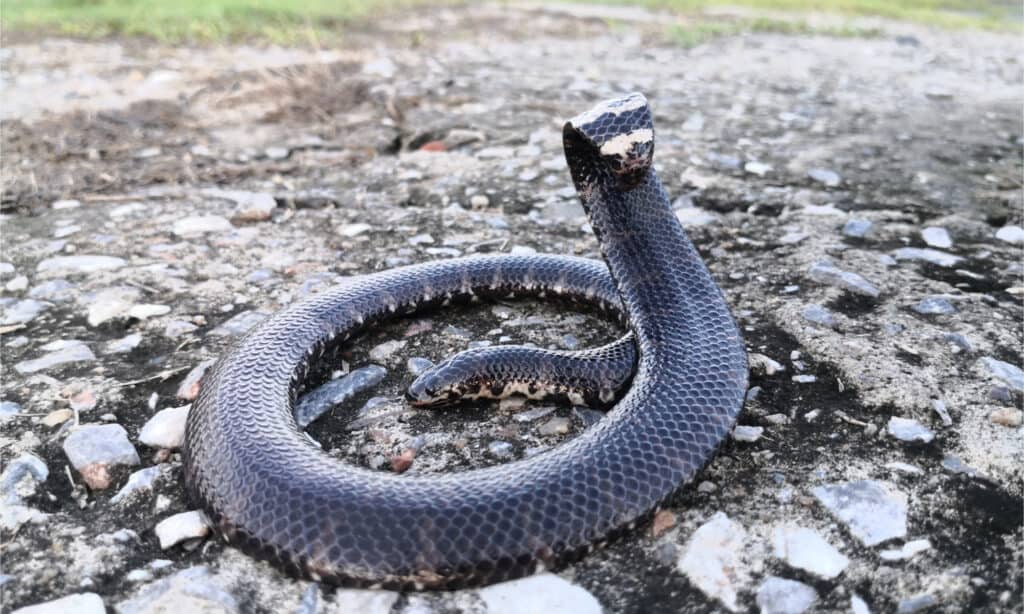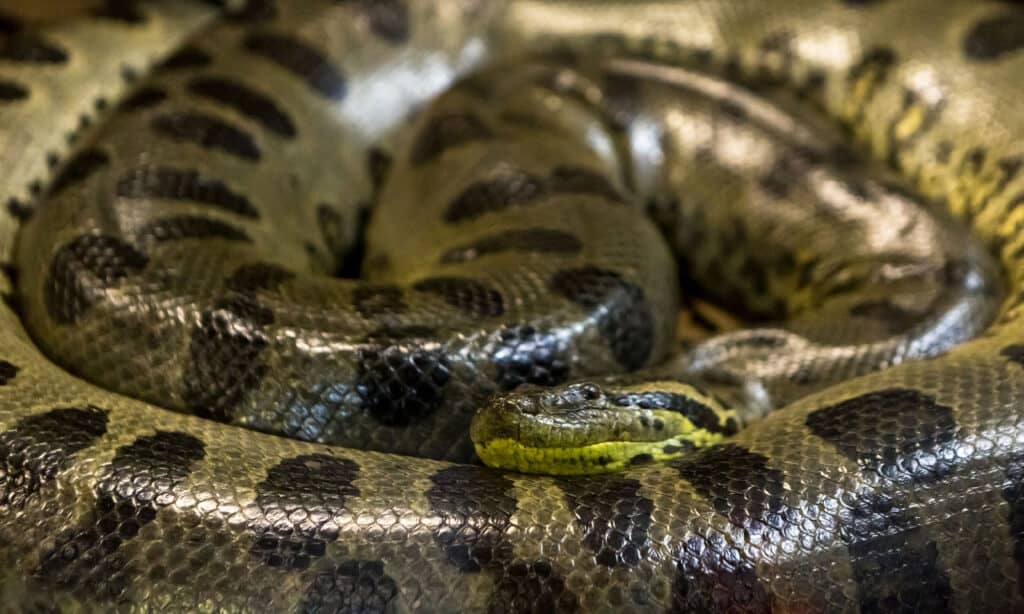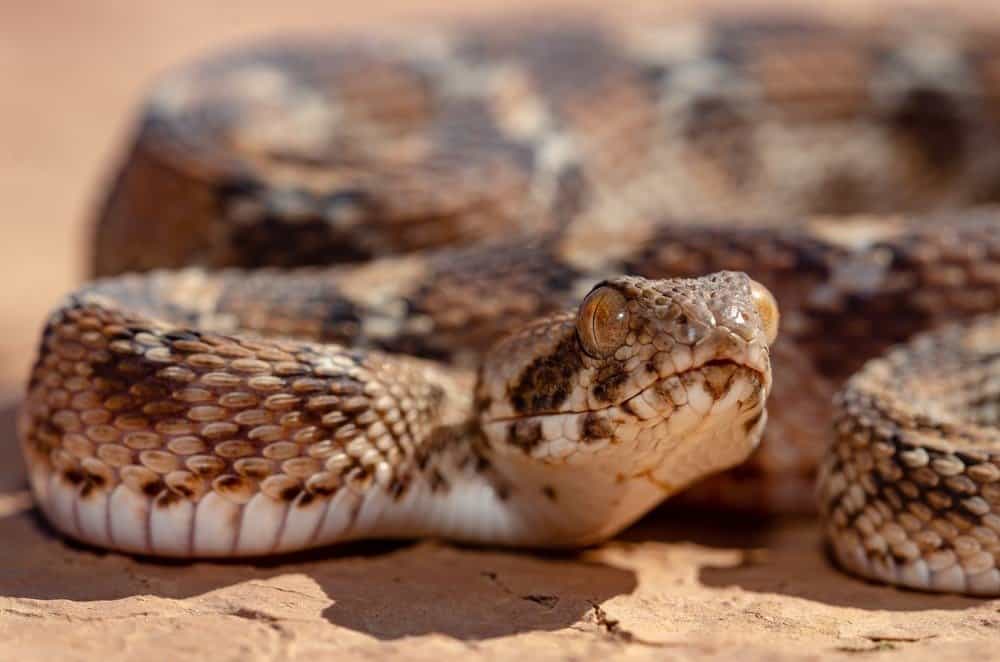Snakes are famous for evoking feelings of revulsion and fear in humans. However, in some cultures, snakes are revered as symbols of healing and fertility. Whatever view you take of these reptiles, it’s a fact that we must share our world with them. Find out how many snakes are in the world, whether or not they are deaf, and which ones you should watch out for!
What is a Snake?

Snakes are legless, elongated reptiles belonging to the suborder
Serpentes.
©Henner Damke/Shutterstock.com
Snakes are legless, elongated reptiles that belong to the suborder Serpentes. They are ectothermic (or cold-blooded), meaning they rely on their surroundings to regulate their body temperatures. Their skin is covered in scales. They shed this skin periodically.
Many people think snakes are blind and deaf. This is not true! Although snakes lack eyelids and their vision is poor, they are technically able to see. They compensate for their poor vision by flicking out their tongues. This allows them to draw in scents from the air to be sampled by a special organ in their mouths.
Similarly, although snakes live without external ears or eardrums, they can still interpret many sounds based on their sound waves. Vibrations from these waves travel through the ground and air. Snakes use their skin, muscles, and tiny bones connected to their jaws to transmit these sounds to their brain.
Strangely, not all legless reptiles are snakes. Some are actually lizards! There are 17 species of legless lizards in the world, including the Cape snake lizard and the California legless lizard.
How Many Snakes Are in the World?

There are over 4,000 species of snakes in the world. Only about 600 of these are venomous.
©aDam Wildlife/Shutterstock.com
There are over 4,000 snake species in the world. Of these, about 600 are venomous. Only about 200 species of venomous snakes are capable of harming or killing human beings. Given this, fatal snake bites are less common than people think.
It’s impossible to know the exact number of individual snakes in the world, given their reclusive habits. However, individual species estimates are sometimes possible. For example, scientists estimate that there may be as many as 1 million common garter snakes in the wild.
Which Country Has the Most Snakes?
Brazil has more snake species than any other country in the world. There are over 375 species living in this country, some harmless and some dangerous. Brazil is home to 60% of the South American rainforest, which is a fertile breeding ground for these reptiles.
Perhaps the most famous Brazilian species are the constrictors, non-venomous snakes that kill by crushing their prey. The most fearsome of these is the anaconda, a massive snake that can swallow a human whole. Other examples of constrictors include the boa constrictor and the emerald tree boa. Brazil is also home to venomous snakes, including the fer-de-lance and coral snakes.
Snakes are found in many different habitats throughout the world. Most are landbound, but others, like the yellow-bellied sea snake, live in bodies of water. Besides rainforests, snakes live in deserts, grasslands, swamps, and urban environments.
Places in the World Without Snakes
Several places in the world exist without snakes. Ireland, Iceland, Greenland, New Zealand, and Antarctica are all snake-free. This list also includes some small Pacific islands like Kiribati.
New Zealand’s snake-free status rightfully raises eyebrows. Why should this small country be devoid of snakes when its neighbor, Australia, is crawling with them? The answer appears to be its constantly changing conditions. New Zealand has undergone many land shifts over the past few millions of years, making its climate unpredictable. For animals that rely on their surroundings for temperature regulation, these are unworkable conditions.
However, sea snakes visit the island from time to time. The yellow-bellied sea snake and the yellow-lipped sea krait occasionally brave the chilly waters around New Zealand.
The World’s Biggest Snake

The green anaconda is the world’s heaviest snake and almost the longest.
©iStock.com/MaRabelo
The world’s biggest snake is the green anaconda. This snake can grow up to 30 feet in length and weigh up to 550 pounds! Females are typically larger than males. It dwells in the rainforests and swamps of Brazil and feeds on wild pigs, deer, caiman, capybara, large birds, and any other prey it comes across.
The 6 biggest snakes in the world are all pythons, otherwise known as constrictors. The name is gruesomely appropriate. Constrictors kill their prey by squeezing them with their powerful bodies until they die. However, suffocation is not usually the cause of death. Pythons constrict the blood vessels of their prey, cutting off blood flow and possibly over-pressurizing the brain. For this, they need big bodies and strong muscles.
The World’s Smallest Snake

The Barbados threadsnake is the world’s smallest snake.
The world’s smallest snake is the Barbados threadsnake, found in Barbados. It grows to a maximum length of 4.09 inches and can be as small as 3.94 inches! On average, it weighs 0.02 ounces.
Females give birth to only one egg at a time, which yields a baby snake already half her size. Scientists recently recognized the Barbados threadsnake as its own species in 2008. They have already declared it to be critically endangered.
The World’s Most Dangerous Snake

The saw-scaled viper is the most dangerous snake in the world, killing more people annually than other snakes.
©Luis Montero de Espinosa/Shutterstock.com
Going by the number of human deaths, the world’s most dangerous snake is the saw-scaled viper. Though it is not the most venomous snake in the world, it is highly aggressive and irritable. Its bite has enough venom to kill up to 6 people at once. In fact, this snake kills as many as 50,000 people a year, more than any other snake in the world. It can be found in parts of Africa and Asia, including the Middle East.
The most venomous snake in the world is the inland taipan, though it causes far fewer fatalities than the saw-scaled viper. With its extremely potent venom and a habit of biting repeatedly, it is rightfully feared in its homeland, Australia.
Snake Diet and Predators

Snakes are strictly carnivorous, never consuming plant material. They rely on calorie-dense food to survive since they only eat once every few weeks. Depending on their species, they eat insects, eggs, small rodents, birds, fish, bats, lizards, worms, and other snakes.
Snakes may be fearsome, but they aren’t invulnerable. Their predators include mongooses, bobcats, coyotes, foxes, raccoons, wild boars, snapping turtles, large birds of prey, and other snakes.
Are Snakes Endangered?
Most snakes are not endangered. However, a few species have made the list. Saint Lucia racers, otherwise known as ornate ground snakes, are the most endangered species of snake in the world. Fewer than 20 individuals remain on earth today. Pfeffer’s reed snakes also face the threat of extinction and are extremely rare.
Snakes face extinction due to several factors. Habitat loss is the most serious. Many species of snakes have lost up to 90% of their habitat. They also face disease, pollution, and the threat of invasive species. In addition to this, humans sometimes try to exterminate populations of snakes that they perceive to be a threat.
However, snakes are vital members of their ecosystems. They provide prey for other animals as well as keep other populations in check. Moreover, they make excellent pest control agents, as they frequently feed on rodents and insects.
Snakes are a necessary, sometimes deadly, and often beautiful presence in the natural world. Despite our very human fears, their loss would have serious consequences.
The photo featured at the top of this post is © reptiles4all/Shutterstock.com
Discover the "Monster" Snake 5X Bigger than an Anaconda
Every day A-Z Animals sends out some of the most incredible facts in the world from our free newsletter. Want to discover the 10 most beautiful snakes in the world, a "snake island" where you're never more than 3 feet from danger, or a "monster" snake 5X larger than an anaconda? Then sign up right now and you'll start receiving our daily newsletter absolutely free.
Thank you for reading! Have some feedback for us? Contact the AZ Animals editorial team.







